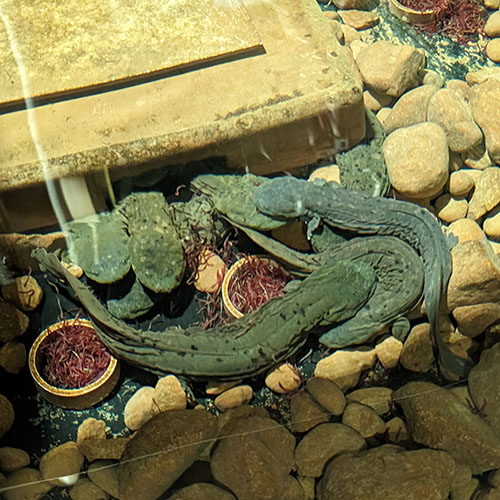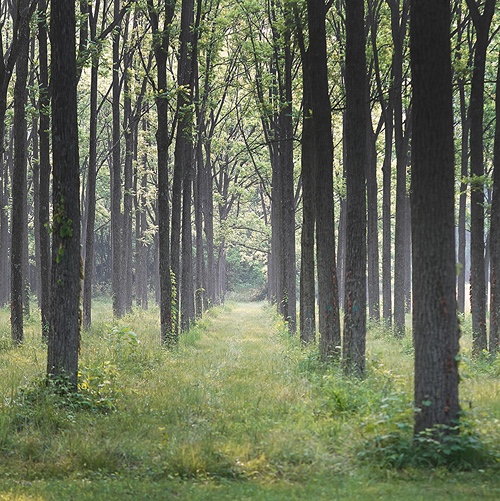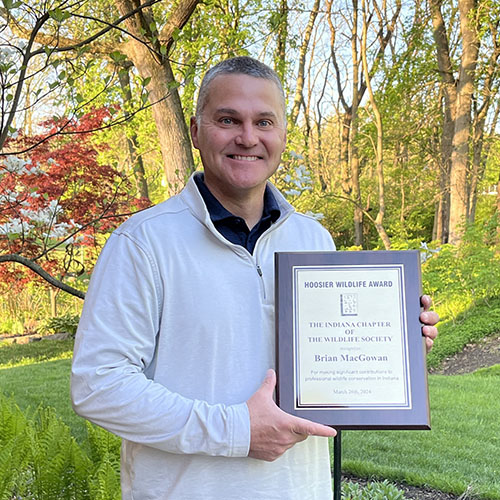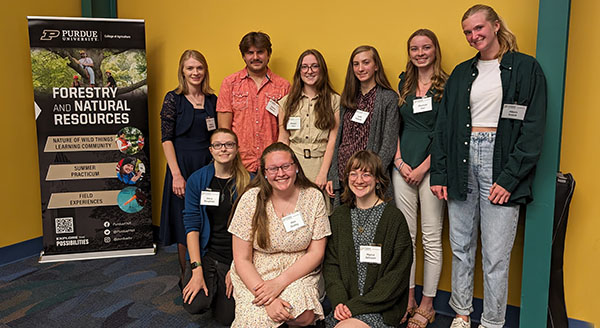In 2023, our FNR Extension website featured stories on topics ranging from wildlife identification, concerns in forestry, urban forestry issues and aquaculture how-to guides. Here are the top stories our FNR Extension readers were interested in last year from archival favorites to new publications on our Got Nature! blog.
From The Archives - Articles originally posted prior to 2023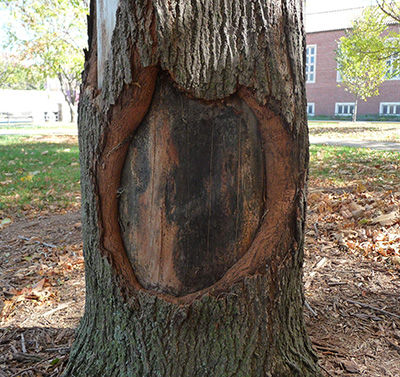
1 - Tree Wounds and Healing -- Trees are incredible survivors in spite of the challenges from pests of all kinds, including us! They are vulnerable to injuries such as mechanical wounds from lawn equipment, vehicles and ice. Pruning results in an intentional wound which is of importance to consider. Tree owners and managers need to prune trees to maintain aesthetic characteristics, remove infected limbs, reduce risk, or improve structural stability. Proper pruning practice and understanding tree wounds can minimize the impact of creating wounds on trees.
2 - Question: Can Tree Roots Cause Damage to a Home's Foundation? -- A reader asked this question regarding a pin oak tree that is within 10 feet of their house after receiving A certified arborist took a look at it and said that he would like to use an Air Knife to expose the roots near the foundation (a walkout basement) to determine if the roots are causing damage and/or need to be pruned, or whether the tree needs to be removed since it is situated too close to the house.
3 - Question: I Saw A Squirrel with No Fur on Its Neck, Both Backside and Underneath. What Is This? -- People can be taken aback by the sight of squirrels missing hair. Sightings of partially furred squirrels is not unusual with warmer temperatures experienced through the winter. Like many wildlife issues, the cause of hair loss in squirrels is not easy to answer and often results in more questions than answers. In most situations, hair loss does not impact populations of squirrels.
4 - Be on the Watch for EHD in Deer -- In August 2019, residents were warned to be on the watch for Epizootic Hemorrhagic Diseases (EHD) in deer after a white-tailed deer in Clarke County, Indiana tested positive for Epizootic Hemorrhagic Disease (EHD), and potential EHD cases had been reported in 26 other Indiana counties. Here are a few things you should know about how EHD, how to spot it, and how to report it.
5 - Question: Are Carpenter Ants Harmful to My Tree? -- Carpenter ants are very common inside trees, especially on larger, mature trees that are hollow with cavities. They nest in rotted, decayed wood, although some nests may extend into sound heartwood in the center of the tree. Carpenter ant presence is an indication of rotting wood, and infested trees should be checked to determine whether the rot has weakened the tree enough that it has become a risk of failure.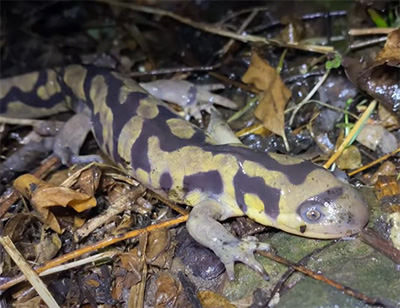
6 - Question: Why Are There So Many Acorns This Year? -- If you have ever noticed acorns so numerous that you could not take a step without crushing several, you may be asking the question, “why are there so many acorns?” Some answers to this question can be found in the physiology and ecology of trees and their relationship to wildlife.
7 -It Is A Salamander. No, It Is a Lizard. Are They Different? -- Salamanders are often mistaken for lizards, but the two groups are very different. Learn the differences between lizards and salamanders, how to identify each and more.
8 - Question: Blue Spruce is Dying, What Can I Do? -- A reader sent in a question asking about a 40-year old spruce which is dying in the middle. There was a concern about Rhizosphaera needle cast as well as questions about fungus control sprays or alternative fungicide treatments. 
9 - Slime Flux of Trees -- Slime flux (also known as wet wood) is a dark, foul-smelling and unsightly seepage of sap from tree trunks. The disease is not usually a serious problem but the appearance can be alarming. Learn about the symptoms of slime flux, diagnosis and prevention measure.
10 - What Do Trees Do In the Winter? -- Do they freeze up like unprotected water pipes? Or burst when it gets below freezing? Yes, the below-ground parts of a tree are kept insulated by mulch, soil and a layer of snow, and that is important to survival, but the exposed parts of a tree are not protected.
Top Articles posted in 2023
The most read stories first posted in 2023 on our Got Nature blog range from editions of the Intro to Trees of Indiana and the ID That Tree series to questions about woodland treatments and educational opportunities.
1 - Forest Management for the Private Woodland Owner Course -- Are you a landowner looking to learn about the biology and management of forests? Do you want to learn about the resources and professional assistance you can access to help form your property management goals and pursue your objectives for your land? Sign up for the Purdue Extension Forest Management for the Private Woodland Owner course, either virtually or through an in-person course.
 2 - Intro to Trees of Indiana: Osage Orange -- Meet the Osage Orange or Maclura pomifera, also known as the hedge apple. While this species is not native to Indiana, it is found throughout the state, where it was planted for fence rows and fence post plantings due to its decay resistant wood. The fruit of Osage orange, produced by female trees, also is a key identifying characteristic, as it resembles a large yellow-green-colored bumpy orange or a bumpy green apple.
2 - Intro to Trees of Indiana: Osage Orange -- Meet the Osage Orange or Maclura pomifera, also known as the hedge apple. While this species is not native to Indiana, it is found throughout the state, where it was planted for fence rows and fence post plantings due to its decay resistant wood. The fruit of Osage orange, produced by female trees, also is a key identifying characteristic, as it resembles a large yellow-green-colored bumpy orange or a bumpy green apple.
3 - We Need Your Help, Report Wilting Sassafras Trees in Indiana! -- Sassafras trees are an important understory tree that aids in nutrient cycling and are important food sources for deer and rabbit populations in the winter months. At this time, we do not know what is killing our native sassafras trees or the range of impacted trees. We need more help in identifying locations of wilting sassafras trees.
4 - Intro to Trees of Indiana: Persimmon -- Meet the persimmon or Diospyros virginiana, one of Indiana’s fruit producing trees. The alternately held leaves of persimmon are oval shaped with smooth margins, with no lobes or teeth. The thick dark green leaves turn yellow or reddish-purple in the fall. The fruit, a pumpkin orange colored fleshy plum-like fruit, is a standout characteristic and is favored by both wildlife and humans.
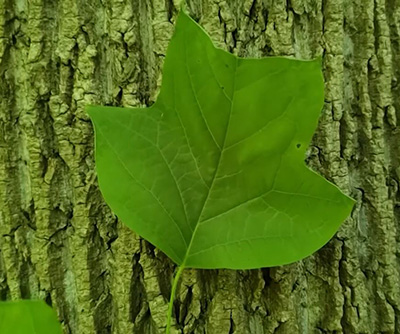 5 - Intro to Trees of Indiana: Tulip Tree -- Meet Tulip tree or Liriodendron tulipifera. The state tree of Indiana, also known as the tulip poplar or yellow poplar, is easily identified by its large, simple tulip shaped leaves held alternately on long leaf stems. The leaves, which feature three lobes, including the top lobe which is widely notched in the middle, turn from glossy green to a golden yellow in the fall. In the spring, the tulip tree produces colorful green and yellow, tulip like flowers with an orange band at the base of each petal, which bloom in May or June, but are often found high up on the tree.
5 - Intro to Trees of Indiana: Tulip Tree -- Meet Tulip tree or Liriodendron tulipifera. The state tree of Indiana, also known as the tulip poplar or yellow poplar, is easily identified by its large, simple tulip shaped leaves held alternately on long leaf stems. The leaves, which feature three lobes, including the top lobe which is widely notched in the middle, turn from glossy green to a golden yellow in the fall. In the spring, the tulip tree produces colorful green and yellow, tulip like flowers with an orange band at the base of each petal, which bloom in May or June, but are often found high up on the tree.
6 - Intro to Trees of Indiana: Sycamore -- We meet Sycamore or Platanus occidentalis. The large leaves of this species have three to five lobes and loosely resemble that of maples, but are significantly larger and are alternately held, versus the opposite leaf arrangement of maples. The bright green, broadly toothed leaves and stems are slightly fuzzy to the touch. The fruit of the Sycamore is a soft, one-inch brown ball-like seed head, which hangs on a long stem.
7 - ID That Tree: Invasive Tree of Heaven -- In this episode of ID That Tree, Purdue Extension forester Lenny Farlee identifies the invasive tree of heaven, also known as stinking sumac, due to the foul odor that permeates from nearly all parts of the tree. The alternately held compound leaves have teeth at the base of the leaflets on stout stems, while the bark is a medium gray with white wormy marks.
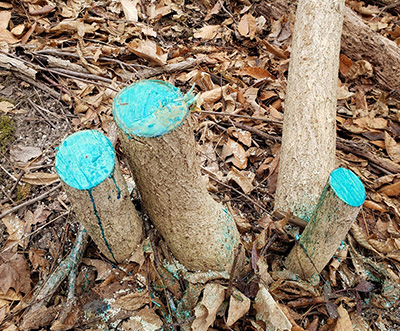 8 - Question: What Is the Best Treatment to Control Unwanted Trees or Brush in Woodlands? -- A reader asks about a grove of young white oak and hickory trees that have black locust creeping into them, wondering if cutting them down and treating the stumps is the best method to control the brush? Extension forester Lenny Farlee explains the cut-stump method as well as valuable tools and treatments that may be utilized for tree and brush removal.
8 - Question: What Is the Best Treatment to Control Unwanted Trees or Brush in Woodlands? -- A reader asks about a grove of young white oak and hickory trees that have black locust creeping into them, wondering if cutting them down and treating the stumps is the best method to control the brush? Extension forester Lenny Farlee explains the cut-stump method as well as valuable tools and treatments that may be utilized for tree and brush removal.
9 - Intro to Trees of Indiana: Sassafras -- Meet Sassafras or Sassafras albidum. The alternately held leaves of this species all have untoothed margins and smooth leaf surfaces, but they may be variable in shape, ranging from no lobes or two or three lobes, and all three variations may even be found on the same branch. In the spring, the sassafras produces clusters of small yellow flowers. In the fall, the species produces a dark blue or purple berry-like fruit, which is held on bright red or orange stems.
10 - Intro to Trees of Indiana: Redbud -- Meet the Redbud or Cercis canadensis. The alternately held leaves of this small tree are heart-shaped with smooth edges and that measure three to five inches long. The clusters of pink, lavender and even magenta flowers of this species appear in the early spring before the leaves open. The redbud is in the broad legume family and, as such, its fruit is a small pea-pod, approximately three inches long, which is flat with a very thin skin.
The Purdue FNR Extension website and Got Nature! blog are a compilation of internally created resources along with important shared by partner organizations such as The Indiana Woodland Steward, the Indiana Department of Natural Resources - including the Division of Forestry and the Division of Fish and Wildlife, and the Purdue Landscape Report among others.


